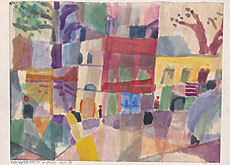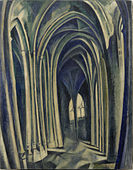第3次談德洛涅夫妻的藝術2024:抽象畫與抽象的頓悟 sartorial origins of abstraction. 我報導過2次:神遊 (17) 2021;感動我的 (17):《德洛涅》為例, 第一位抽象畫者,出自小說《間諜》The Secret Agent(1907)。 讀紐約時報資料庫中尋" Delaunay",結果偏重Sonia Delaunay (1885 – 1979): Robert Delaunay (1885~1941) : Saint-Séverin 的 Saint-Séverin 教堂 (巴黎) 組畫. Klee translated an article in 1913, entitled "La Lumière" (or "Light").--- 禮拜天美術神遊 (17) 2021.1.18
紐約時報的
Delaunay
April 25 2024
ART & DESIGN


In their six-foot-long accordion book, “The Prose of the Trans-Siberian and of Little Jeanne of France” (1913), Sonia Delaunay “stenciled serpentine, tutti-frutti shapes in gouache alongside a column of verse by Blaise Cendrars.”Pracusa and Succession Cendrars, via The New York Public Library
- April 18, 1880
2021.1.18
禮拜天美術神遊 (17) : Robert Delaunay (1885~1941)Sonia Delaunay (1885 – 1979) : Saint-Séverin 的 Saint-Séverin 教堂 (巴黎) 組畫. Klee translated an article in 1913, entitled "La Lumière" (or "Light").
感動我的 (17):
?
台灣抽象藝術史 = History of abstract art in Taiwan / 蕭瓊瑞著
西方的第一位抽象畫者,出自Joseph Conrad約瑟夫·康拉德的小說The Secret Agent《間諜》(1907)
Title: The Secret Agent《間諜》(1907)
A Simple Tale
Author: Joseph Conrad約瑟夫·康拉德Joseph Conrad
A harsh laugh from Comrade Ossipon cut the tirade dead short in a sudden faltering of the tongue and a bewildered unsteadiness of the apostle’s mildly exalted eyes. He closed them slowly for a moment, as if to collect his routed thoughts. A silence fell; but what with the two gas-jets over the table and the glowing grate the little parlour behind Mr Verloc’s shop had become frightfully hot. Mr Verloc, getting off the sofa with ponderous reluctance, opened the door leading into the kitchen to get more air, and thus disclosed the innocent Stevie, seated very good and quiet at a deal table, drawing circles, circles, circles; innumerable circles, concentric, eccentric; a coruscating whirl of circles that by their tangled multitude of repeated curves, uniformity of form, and confusion of intersecting lines suggested a rendering of cosmic chaos, the symbolism of a mad art attempting the inconceivable. The artist never turned his head; and in all his soul’s application to the task his back quivered, his thin neck, sunk into a deep hollow at the base of the skull, seemed ready to snap.
奧西彭同志一聲刺耳的笑聲,使他的長篇大論戛然而止,使徒的舌頭突然結結巴巴,而使徒溫和而崇高的眼神也顯得迷惑不定。 他慢慢合上眼睛一會兒,彷彿要整理一下亂七八糟的思緒。 一片寂靜。 但是,由於桌子上方的兩個燃氣噴嘴和維洛克先生店後面的小客廳裡發光的格柵,變得非常熱。 維洛克先生極不情願地從沙發上下來,打開通往廚房的門,呼吸更多的空氣,從而露出了天真無邪的史蒂夫,他安靜地坐在交易桌上,畫著圈子,圈子,圈子。 無數的圓,同心的,偏心的; 圓形的光輝旋轉,透過它們糾纏在一起的大量重複曲線、統一的形式和混亂的相交線,暗示著宇宙混亂的渲染,象徵著一種試圖不可思議的瘋狂藝術。 藝術家從未轉過頭; 在他全神貫注於這項任務的過程中,他的背部顫抖著,他細細的脖子陷入了頭骨底部的一個深深的凹陷中,似乎隨時都會折斷。
Robert Delaunay: Disque1912
感動我的 (17): Parables of Sun Light by Rudolf Arnheim 精簡,頁頁啟發讀者。何政廣的藝術家出版社,世界名畫家全集161本,Robert Delaunay《德洛涅》為例, 第一位抽象畫者,出自小說《間諜》The Secret Agent(1907),比較 Robert Delaunay: Disque1912. TOYOTA 車展"氫石窯"牛角麵包請客
Robert Delaunay (12 April 1885 – 25 October 1941) was a French artist who, with his wife Sonia Delaunay and others, co-founded the Orphism art movement, noted for its use of strong colours and geometric shapes. His later works were more abstract. His key influence related to bold use of colour and a clear love of experimentation with both depth and tone.
Sonia Delaunay (14 November 1885 – 5 December 1979) was a Ukrainian-French artist, who spent most of her working life in Paris. She formally trained in Russia and Germany before moving to France and expanding her practice to include textile, fashion, and set design. She co-founded the Orphism art movement, noted for its use of strong colours and geometric shapes, with her husband Robert Delaunay and others. She was the first living female artist to have a retrospective exhibition at the Louvre in 1964, and in 1975 was named an officer of the French Legion of Honor.
Her work in modern design included the concepts of geometric abstraction, and the integration of furniture, fabrics, wall coverings, and clothing into her art practice.[1]
Robert Delaunay Saint-Séverin
https://en.wikipedia.org/wiki/Robert_Delaunay
Église Saint-Séverin
****
The physical and emotional impact of colour
 Center Paul Klee
Center Paul KleePaul Klee’s interest in colour was two-sided: empirical and emotional.
When though, Paul Klee first met the French painter Robert Delaunay in 1912, he got interested in painting in colour. Robert Delaunay's work is attributed to the “orphic” Cubism, also called Orphism. Examining the work and ...
Intense light
A major influence on Klee, where colour was concerned, was the French artist Robert Delaunay, for whom Klee translated an article in 1913, entitled "La Lumière" (or "Light").
The following year, Klee made a journey to Tunisia, where he discovered the emotive intensity of colour. His direct experience of the sensuality of the southern light was decisive on his work.
Until that time, Paul Klee had produced many drawings and graphic works but had painted relatively little, and then mainly in watercolour.
After the trip to Tunisia, it was as if Delaunay’s ideas, on which Klee had meditated a great deal, had fermented within him, giving birth to his own pictorial language.
Rainbows
Delaunay had also given Klee the idea of working directly on the colour spectrum.
As Klee wrote, the rainbow... "standing above every coloured thing, is the abstraction of every application, elaboration and combination of colours".
It is interesting to note how Klee’s discovery of colour was followed by greater mastery of the technique of oil painting.
His compositions became more abstract, while exhibiting greater freedom of movement and gesture. The titles often refer to personal situations and experiences.
Values such as the dynamism of movement and the relationship between individual and cosmic energy began to emerge.
A few years later, taking these ideas as his foundation, Klee formulated his concept of Romanticism as a form of expressive freedom antithetical to Classicism.
Newsletter
Sign up for our free newsletters and get the top stories delivered to your inbox.
Artist and scientist
Where research into colour is concerned, Klee made a dual contribution to modern art: as artist and as scientist.
Klee worked on colour with intuition and emotion and also with a methodological apparatus, which served to advance theoretical research in this domain.
"He interpreted Robert Delaunay’s theory of light and colour in a very personal way, turning it into his own pictorial poetic. But at the same time he conducted methodical experiments to broaden the scale of colour interaction, exploring complementary contrasts, or contrasts between warm and cold colours," explains Baumgartner.



沒有留言:
張貼留言